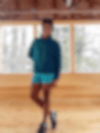March 2021 Newsletter
Editor
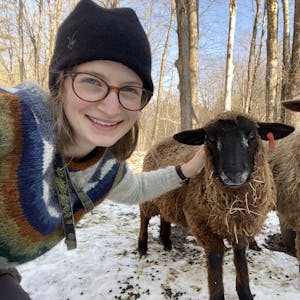
Amanda Kievet
Trail runner, wool mill owner, web developer, quote unquote farmer.
Article Collection
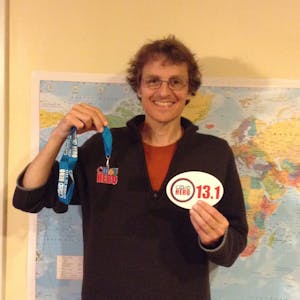
Geoff Dunbar
Former UVRC president, co newsletter editor, and UVRS coordinator.
Table of Contents
- Letter from a Board Member: Making Running Yours by Robert “RJ” Jones
- Pick Up Cool UVRC Face Mask at Lebanon Recreation Arts and Parks by Jim Burnett
- UVRS 2021 February Update by Geoff Dunbar
- Lone Runner Challenge: Wear The Hat by Tim Smith
- The Moral of the Story by Ellie Ferguson
- Face Mask and Heart Rate - An Experiment by Tim Smith
- Chris Welker by Matt Sherman
- SRK Greenway, central NH by Jennifer Hansen
- Ask the Coaches: Training Later in Life?
Making Running Yours
By: Robert “RJ” Jones
Hello UVRC Friends! For those of you are long time members; I’m glad you’re still here! And for those of you that are new to the club; welcome! I’m sincerely happy you are with us and that we continue to grow this local running community! Now that you’re part of the running club I can let you in on a UVRC trade secret: you are a runner. Surprise! Perhaps that seems obvious or perhaps you have doubts, but I feel it bears mentioning because there is still the perception that there is some pace or skill requirement before you can call yourself a runner. That is false my good people. If you move with intent by whatever means are available to you, you are a runner in the eyes of this club. The distance you go and the pace you do it at does not define your runner status. I think we as humans get a healthy dose of imposter syndrome elsewhere and we don’t need it in things that we do for our health, wellness, or just for funsies. So long story short, you are a runner, welcome to the club!
Now that that is out of the way I want to talk about something related to my preamble which is running philosophy. A broad topic for sure but one that I think is important to making running part of your life, especially nowadays when I imagine that for many of us running is an anchor for our mental health and wellness. I want to talk specifically about ways you might adapt your philosophy to make running yours and finding your reason to run. And I’ll use the only human example I am 100% qualified to discuss and comment on, which is myself.
I’ll let you in on another secret since we are friends now, I used to hate running with an unbridled passion (but now I love it). Yup, this sounds like the beginning of an infomercial for a “life changing tool” but it is true. In the past I’m sure I have said such dramatic things like “running is the absolute worst” and “running is a punishment devised by an angry god”. A bold claim but even now I sometimes agree with it, but in the same way that having to go through the effort of making dinner after work when you are bone tired is “the absolute worst”. Point being, that until running became something I was invested in, it was suffering. I chose to invest in running by making it mine.
Running is beautiful in that it is one of the few sports that is absolutely unrestricted. No real rules, no real guidelines, no real limits, just you and how you choose to do it. Because I’m a control freak on the inside, I made running mine by making it personal through things that make me happy. Things like style and music. I’m going to stress the first part “style” because that was really the cincher for me, everything else was just frosting on what eventually became a delicious cake. I’ve often said; “glam game, is the most important game” which is because at least for me everything changes when I feel as though I’m “looking fly”. There is even some science showing that you do in fact feel more confident, engaged, and even productive when you dress for success. That isn’t to say that you have to “dress like a runner” but rather you can change how you feel about running by making a conscious decision about your outfit. For me this involves a lot of bright colors and color coordination which admittedly makes me look a bit like a Power Ranger but it also requires an investiture of time that gives me a sense of ownership. In the beginning it also became part of my commitment to keep running. I usually run after work so it can be very easy to bail because I’m too tired, especially when I first started running. But this got a lot harder to do when I had already went through the trouble of picking out my running outfit and taking it to work; like somehow my clothes would be disappointed in me if I flaked on them. So time and time again I would lace up, dawn my aesthetically formidable color coordinated outfit, give myself a quick look in the mirror with a “looking good buddy” nod, and hit the pavement. While I could have good runs and bad runs depending on a lot of variables I could always be in control of how I looked. And the fact that I knew I looked good quite simply made me feel good. Dressing up became a practice that I enjoyed that set the mood for me at the onset and eventually practice led to habit, and habit led to enjoyment and a source of fulfilment. Now while the outfit does wonders for the mood it can’t always be enough to sustain you through a long run, which is where the music comes in.
My running playlists are 90% music from anime and video games with high BPM, overflowing with energy, funky lyrics or lyrics in a language I do not speak. All of which together create a soundtrack for my runs that make it scientifically impossible to not feel pumped and energetic. You try listening to this: https://music.youtube.com/watch?v=_qYYetCVBko and not feeling like you’re ready to go fight the bad guys and save the world. Can’t be done. And the lack of lyrics or at least lyrics that I do not understand or don’t really need to listen to allows my mind to focus more on the intent and feel of the music. Each song in the playlist has an intended effect or place in the run; higher energy songs for hills, heavy four on the floor beats for straight flat sections that benefit from good pacing, more bubbly songs for the ends of the runs when I’m running on fumes and need a boost. And again, going through the effort of crafting a playlist and seeking out songs made me invested in the run that they would feature as the soundtrack for. It wasn’t long before I got in the habit of christening a new playlist with a run or saying things like I can’t wait to run to this!” These curated playlists ended up being another way I decided to claim running for myself, invest in it, and eventually turn it into something I love.
Through style and music I decided to shape running into something that was unique to me. They gave me an aspect of running I could look forward to that made it easier to get through the self-doubting and demotivational slog I think many people new to running, including myself, get that make us want to throw out our shoes and never run again. But don’t give up friends! Running is definitely a physical challenge but it is also a mental one, and by adapting your running philosophy you can bring your mental A game! And I fully acknowledge that the ability to afford stylish running gear and having the time to spend crafting a playlist come from a place of privilege, but that doesn’t mean there aren’t countless other ways you can claim your run. I chose ones that align with my interests but for you it could be running to or around beautiful places, using the tracking paths of your runs to make images, or just claiming the time that you are running to think about certain things or nothing in particular and zone out. The more you can make running feel like it belongs to you, the better you’ll feel about it. So find something you enjoy and think of a way you can fold it into your running, to make your brand of running yours!
Also in case you were curious, my favorite songs to run to right now are “GAS GAS GAS” by Manuel (https://music.youtube.com/watch?v=atuFSv2bLa8&feature=share) and “Maniac feat Yann Ligner” by Carpenter Brut (https://music.youtube.com/watch?v=LcI8sfwxvIs&feature=share). They have so much manic energy it’s hard not to have a little extra pep in your step. And this song (https://music.youtube.com/watch?v=mJ1N7-HyH1A&feature=share) which I think is Japanese so I don’t actually know the name but the cascading piano rifts and bubblegum vibes just make it feel like a happy song.
Pick Up Cool UVRC Face Mask at Lebanon Recreation Arts and Parks
By: Jim Burnett
Current UVRC members can pick up FREE customized UVRC face masks at Lebanon Recreation Arts and Parks, 15 Hanover Street, Lebanon NH by calling and scheduling a pick up. Call 603-448-5121
If you need to join or renew your membership for 2021 in order to be eligible for a free face mask, use the link below.
https://uppervalleyrunningclub.org/join-online
Join in the fun
UVRS 2021 February Update
By: Geoff Dunbar
Due to the ongoing COVID-19 pandemic, road racing in the Upper Valley is, for the most part, on hold until July. There is some optimism that races will take place in the summer and fall, though uncertainty remains.
Per these concerns, we are hoping to do a late-Summer/Fall Upper Valley Running Series, with a reduced number of races (say 3 to 5). It doesn't make sense to firm up plans now, as race directors are uncertain of their plans. We will reconvene in April to see if we can come up with a series at that time, with the intention of announcing the series in May. All these plans are tentative and subject to reconsideration.
Stay up to date on the UVRC website (https://uppervalleyrunningclub.org/), the UVRC newsletter, and UVRC mailing list. You can email the UVRS as well though any updated information will be posted promptly: uvrs@uppervalleyrunningclub.org
Thanks,
Geoff and the UVRS committee
Lone Runner Challenge: Wear The Hat
By: Tim Smith
One of the things I will miss this March (and we missed last year) because of the pandemic is the Shamrock Shuffle. There are all sorts of good things about shuffle season; the sap is running in the maples, teammates who have been buried under six feet of snow start to reappear, and the Shamrock Shuffle is anything but a shuffle - being the fastest miles of the early season.
Undoubtedly one of the cheeriest sights of race day is when the race director stands up to call us to the line - wearing his over sized, emerald green topper. His "chapeau", his "lid". That Irish Green Top Hat. The Mad Hatters Hat!
If I was to win this race, perhaps I would be bold enough to ask Paul Coats if I could don his headpiece the color of the hills of Eire!
Today you can do it! This months challenge - go out and run your own Shamrock Shuffle, photograph yourself, and then use the special-to-UVRC website to add Paul's Emerald crown to your own head.
Then post it for use!
The Moral of the Story
By: Ellie Ferguson
Oh joy, oh joy! Writing as we are expecting a 6-12" of the white stuff. Having been a bit out of commission due to surgery in November and still figuring out the best settings to prod my brain into action, I have been easing back into action. Snowshoeing and (finally) cross country skiing.. 2 busted feet don't like the rigid boots I had and I broke down and got some more forgiving ones on sale at Lahouts. Took them out for their baptism after work(my feet like them).
So the moral of the story is just get out there and do something. Give thanks for the things you CAN do. And a short whatever is better than nothing at all.....
Face Mask and Heart Rate - An Experiment
By: Tim Smith
I'll admit, I don't enjoy wearing a mask while running, but I understand that in these times of pandemic, it is the right thing to do. I know there is now a lot of data which says that transmission of the virus in open air is exceedingly rare. Still, when I meet someone out on the road, I'll pull up my mask; in part to be safe, and in part to demonstrate that I care about my community.
But this article is not about why we wear a mask, but rather how does a mask affect our running.
Ever since I have been running with a mask I have wondered if wearing a mask has a measurable effect. But then after writing about Heart Rate for the December newsletter, I knew I had the tools (my running watch measures heart rate) to do some experimentation. The question is, if I exert the same effort with and without a mask, how will that affect my pace.
So this is how my reasoning went; heart rate is a good measurement of effort. Ideally, I would hop on a treadmill, set the speed, and run a mile with and without a mask, and compare the heart rates from the two trials. Done.
Figure 2
The first problem is, I don't have a treadmill. If I just go out and run I know that my pace will tend to go up and down and my heart rate will too. But that is not too bad. I imagined a graph (see figure 2) with speed or pace on one axis, and heart rate on the other axis. As you go faster/run harder, your heart rate goes up. My watch records heart rate and speed every second. So if I plotted those data points I expect a scatter of points, clustered around a rising line.
But other factors can change your heart rate besides how fast you are running. Heart rate is tied to effort, and around here effort often means am I running up or down a hill. Long, straight level places are hard to find in the Upper Valley. After a bit of exploring I settled on a section of sidewalk next to Rt 10, north of Hanover. From the Fire Hall to Kendall is about a kilometer, and the elevation varies by only 8 feet.
When my plans had evolved to this stage I heard that UVRC was going to be giving out masks when you renew your membership, which solved another one of my problems. Through the fall I had been running with two different masks. One is pretty flimsy, the other an impenetrable canvas. I expect that the measured effect would vary widely, and I wouldn't be able to translate it into anybody else's experience. But now I will use the UVRC mask as my standard - and you can too.
So one fine day I went out and ran a quarter mile slow, then fast, without a mask. And then repeated that trial with a mask - and then went home. That evening when I plotted the data I was disappointed to find it was a mess and there was no clear trend. However upon closer examination I realized that when I did the fast legs, my heart rate had never settled to its final steady state.
A week later I tried again, this time 1000 meters for each trial. Things looked better, but I had probably rushed from one phase to the next. Heart rate lags behind speed.
One final effort. This time with 2000 meters trials, and just trying to keep the pace steady. It will naturally vary, but that I could deal with.
Figure 1
In figure 1 is my final test run, as plotted by Strava. You can see four clear legs. The first and third were with mask on, the others with mask off. I did meet 2 people while in the "no mask" trial, and so slipped on the mask for a short time, but I don't think it affected ("contaminated") the results too much.
In figure 2 I have plotted speed [meters per second] vs heart rate [beats per minute]. The red points are with the mask and the blue points are without the mask. First observation; there is a lot of overlap. In fact a prudent statistician would probably either stop at this stage - or send the experimentalist back out to collect more data. But I am going to press on my analysis - even if I am delving into the statistically insignificant.
One other thing to note in this plot is that heart rate and speed are correlated, as expected. That line, which is a fit to the data, says that with every 10 heart beats a minute, I also gain 10 cm per second. I'll actually use this in a minute to help my analysis.
From this figure the blue (mask-less) tends to be more to the right (faster) than the red. But how much?
Figure 3
For my final plot I am only considering the data points between 143 and 154 beats-per-minute, which is where all the trials had samples. I then take each data point and, using the slope of the line from figure 2, project it to the same heart rate (143 bpm), and plot a histogram for number of samples vs speed (figure 3). The left peak (red) is with a mask, the right peak (blue) is without a mask. The difference is 0.08 meters a second, or 3 inches a second. That is a bit over a 2% effect.
This is the equivalent of always running up a 0.4% grade, gaining 4 meters every kilometer, or wearing a weight vest with 2% of your body weight.
I'll be the first to admit that this analysis is a bit dodgy, but I think that it does tell us that the effect of the mask on our energy consumption is pretty small.
But wearing a mask feels like it should be a 10% effect or more!
I think the answer here is that only the lungs are working harder. Our legs, which are the greatest consumer of oxygen, consume the same amount of oxygen at a given pace independent of whether or not you have a mask on. The diaphragm works a lot harder, but it is still a small part of our total energy consumption.
Finally, I had this idea that I was going to be working significantly harder with a mask on. It might be like training at high altitude. But that was just me trying to make lemonade. The best thing for my training will be when I again can run next to (or behind) fast teammates. I am looking forward to that day when I can see your face.
In the meantime it is only 2%, it is not that bad!
Chris Welker
By: Matt Sherman
Name: Chris Welker
Town: Thetford
Where are you from originally and what brought you to this area?
I’m originally from Milwaukee, Wisconsin. I came to the Upper Valley for graduate school.
What do you do professionally?
I’m a PhD student in the Psych and Brain Sciences department at Dartmouth. My work focuses on conversations and how people connect with each other.
How long have you been running?
I started running in 6th grade, so back in 2006.
How long have you been running competitively?
I started racing when I started running, so I’ve been racing since 2006 as well.
Why do you run?
For so many reasons! The primary one is the sense of clear-headedness that comes with a run. Once I find my stride, I do my best thinking while running. I also love seeing how far I can push myself and enjoy pushing my limits a bit more each year. Finally, running is a great stress reliever and a great time to chat with friends. That sense of clear-headedness also leads to surprisingly deep conversations; it’s always fun to run with other folks.
Best athletic accomplishment and why?
I started running trails more often in 2020 and finished the year by running the Dartmouth 50 with some good friends. That was a pretty special run for me because I bonked hard with over 15 miles left but still managed to finish the run. At the start of the year I had no idea that I could do something like that.
If you like to race, favorite race distance? Why?
The half marathon is my favorite road race because it has such a nice balance between distance and speed. You definitely aren’t plodding along, but you still get into the groove of a long distance race.
Cross training activities?
I cross country ski in the winter. In the summer, I hike and occasionally bike. I’m not sure if this is a real effect, but I often feel very strong and run well after backpacking trips. That’s probably my favorite way to cross train.
Favorite local running route?
I live in Thetford, and one of my favorite longer loops goes down Academy Road, then along Campbell Flats, and finally up Hogback/Godfrey to 113. You get great views coming down Academy, Campbell Flats is beautiful, and the Godfrey climb is pretty fun.
Favorite post run treat?
This is a summer-specific treat, but after a long, hot run I love ice cream.
Strangest place ever run?
Probably Craters of the Moon National Monument in Idaho. I ran there when I was in high school and it just felt like I was on a different planet. It looked a bit like the pictures of Mars from Perseverance.
Any notable streaks or other unusual running events?
Inspired by a friend, I’ve started running my age in miles on my birthday!
What made you start running?
In 5th grade, one of my closest friends trounced me in my middle school’s annual 5K race. I was playing soccer at the time, and he was running cross country. The next year, I decided I wasn’t going to be beaten again and started to run cross country.
Are your reasons for running now the same or different than the reason you first started?
Quite different! Although I still love a competitive 5K, I run for the sake of running now.
Why did you join UVRC?
I didn’t know many folks when I first moved to the Upper Valley, so I decided to see what UVRC was all about. On my first day, everyone I talked to was welcoming, interesting, and kind (and I really enjoyed the workout), so I decided to join.
Hot or cold weather runner?
I’ve been converted to a cold weather runner since moving to the Upper Valley! Before living here I would take winters off, but I’ve realized that – after the first mile or so – running in the cold can be really pleasant. Plus, the mental game of deciding which layers to take off and when to take them off/put them back on can be pretty entertaining.
Morning or evening runner?
I’d love to be a morning runner, but the transition is too daunting. For now, I’m decidedly an afternoon/evening runner.
What is your motivation?
I’m inspired by runs that I’m looking forward to. My motivation often slips when I don’t have a goal – whether it’s a race or a long trail run – that I’m working toward. As a result, I’m almost always trying to plan big runs in the future so that I keep working in the present.
I run therefore I ______________________.
… eat all the time
What does your daily workout consist of?
This really depends on the time of year. I run 4-5 days/week and typically like to fit in two easy runs, a speed workout, a long run, and, if there’s room, a mid-distance run. On one of my off days I usually try some other activity like hiking, skiing, or biking.
How about favorite work out?
My favorite workouts are long runs. It’s easy to fall into an enjoyable rhythm during long runs, the miles just slip by. Long runs also tend to provide the best stretches of mental clarity, so I enjoy them even more when I have a lot to think about.
What’s your favorite pre-run meal?
I like to have a bagel with peanut butter and a banana before big runs.
SRK Greenway, central NH
By: Jennifer Hansen
"The SRK Greenway is a 75-mile loop of hiking trails in central New Hampshire. The Greenway Trail System circles the Lake Sunapee area and connects Sunapee, Ragged, and Kearsarge Mountains."
The SRK Website contains section maps and trail descriptions, and info to purchase a tyvek map of the entire Greenway. I found the little map to be very portable and durable, and I would also read the online section guide before doing each section. https://www.srkg.com/
Percentage runnable: 65-80%
Elevation change: lots of ups and downs
Ease of Navigation: Most of the trail is well- marked with white, trapezoidal metal or painted blazes. Occasionally the trail is hard to follow when it passes through towns or coincides with wood roads.
Parking areas: clearly indicated on maps and in trail descriptions. Some parking is not usable in the winter.
I enjoyed many section runs, alone or with one of my kids, over the last 18 months or so, finishing my last segment at the high spot of the top of Sunapee. Some of the sections include a lot of road running, most notably from the center of Sunapee village to Deer Hill Rd., which is ALL road (trail 3). I found the prettiest/smoothest running segments to be: Section 2 in Sunapee, from a small parking area on Harding Hill Rd., through the Webb Woods to Tilton Park (5.5 miles, would make a nice out-and back); trail 5 from 114 in Springfield to Pleasant Lake in New London (8.4 very hilly miles, might be a nice one to do with a friend and two cars), and Trail 6, from Pleasant Lake in New London to the summit of little Bog Mountain in Wilmot (4.2 miles, another nice out-and-back). It is probably better to do in the summer or fall: I tried a few segments in the winter and either had parking problems or navigation problems (hard to see the white blazes when they are covered over by fresh powder).
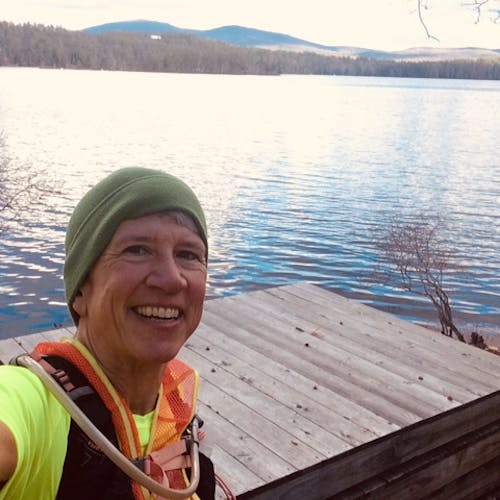
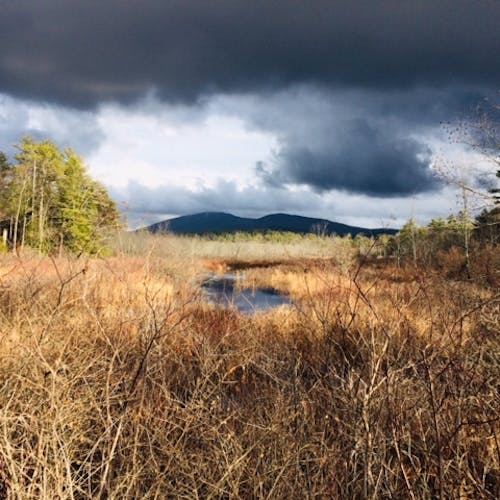
Training Later in Life?
Got a question for the coaches? Send it to newsletter@uppervalleyrunningclub.org and I'll send it on!
I’ve been having conversations with friends who are now middle aged like many of us, and who are getting back into fitness for the first time in many years. Seems like I often say that training now isn’t like we used to do it in our 20s. We can’t go as hard each day, need to consider recovery more, etc. But I wonder, is there much difference in the way coaches coach an athlete in their 20s compared to an athlete 20 or 30 years older? Assuming the same type of fitness goal.
— Paul
Carly Wynn
I see this answer and yes and no. Yes, coaching an athlete changes as the athlete ages in that their training plan and additional supportive & recovery activities will change, compared with their training plan a decade ago. No, in that the same concepts and principles apply: coaching is meant to support the athlete's physiologic adaptation and overall wellbeing, no matter their age, and coaching style varies between athletes for many reasons that have little to do with age.
Training (and coaching) isn't about learning the objectively "best" workouts and doing them as often is possible. It's about finding the combination of workouts and supporting activities (recovery activities) that prompt the body to adapt in the desired way. That adaptation is going to look a little different for every athlete due to a variety of factors. Age is one factor that influences which stimuli will be most adaptive. Workouts are one input that may be adjusted.
In general, recovery time increases as we age. At face value, that is often read as: "aging athletes can't do as many hard workouts as close together as they used to," but phrasing it that way sounds a bit depressing, and overlooks the core principle: time off is a recovery resource that we actively employ to help us adapt optimally. Faced with any stressor above baseline, as we age the body is going to require more and/or different resources to return to baseline, or to strengthen to exceed previous baseline. That includes more time. Other inputs (besides the workouts and the time between them) may also require adjustment as we age: nutrition, sleep, resistance training, and hormone/vitamin supplementation needs, to name a few.
It is also important to note that all of these needs may also change in response to changes other than aging, i.e; excessive external stress, injury, illness, and the systemic changes that come with specific points in aging, such as the onset of puberty and menopause. Any one of these factors may also put an athlete at greater risk for injury or illness, which should always be considered in a training plan. Along with aging also comes the responsibilities and general lifestyle of adulthood, so if you, reader, are noticing that you need to pay more attention to recovery activities than you used to, it may be less a result of chronological age, and more of the additional stresses that come with being middle aged, that 20 year olds may be free of.
So, yes, a training plan for a 45 year old looking to run their first marathon and the plan of a 20 year old with the same goal will look different, but age will be only one reason they look different, and they also will have a lot in common. The basic methods of coaching will be similar. All athletes will, hopefully, be encouraged by their coach to pay attention to their body's cues, and that is my advice to you, reader. If you notice that your training plan from 15 years ago leaves you feeling drained now, a good starting point would be to space your intensity sessions (and potentially your long runs) a little farther apart than you are currently doing. (I will also say, while I have the chance, that although resistance training is important for all athletes, it becomes more important as we age, so make sure you're strength training!)
When selecting a coach, it is important to consider what their specialty is, and whether that aligns with your priorities. Many coaches work with athletes of all ages, but if you want specific attention regarding an age-based consideration, find a coach with some expertise in that area. A first conversation with a potential coach can tell you a lot about where their experience and expertise is.
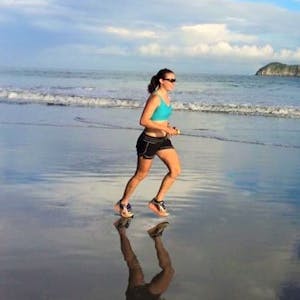
Carly Wynn
Carly Wynn is a personal coach at www.CarlyOutside.com, and can be reached at Carly@CarlyOutside.com
Tim Smith
This is such a great question because there are so many ways of answering it! So I am just briefly going to talk about aging and running, training and lifestyle, and finally how have coaches evolved.
So, you are no longer 24 years old, what can you expect out of your running? (Eliud Kipchoge was 34 when he broke the 2:00:00 marathon barrier.)
Aging and Running
First, I've included one of my favorite plots about running and aging; this is the data on which "Age Graded Scores" are based. The figure below is the world record for each age for the half-marathon. The red curve is the line that age-graded scoring uses. The green line is one-hour, and I included it as a convenient reference to guide the eye. The takeaway here is that as we get older, we do get slower, but not that much.
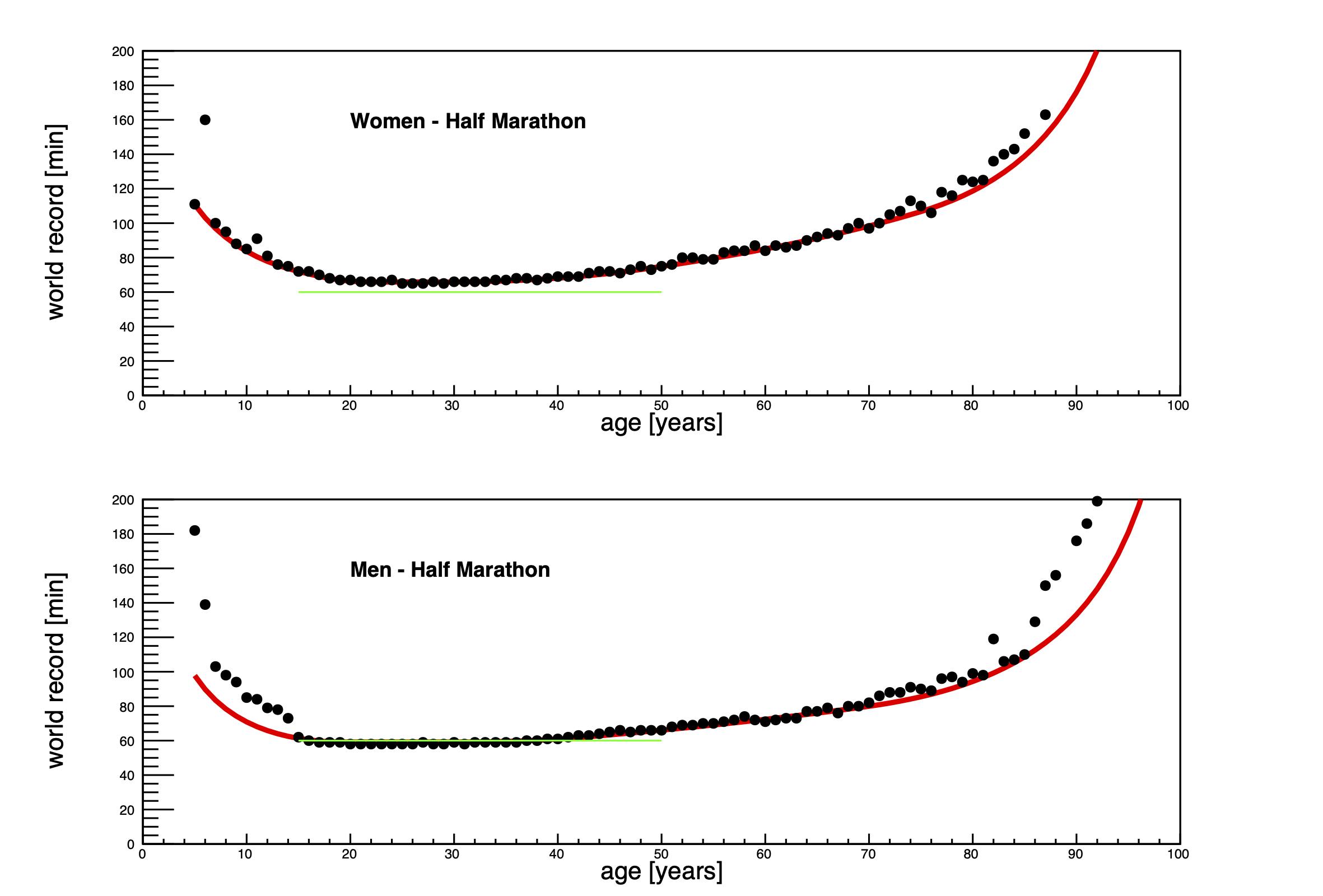
Training and Lifestyle
I find that the greatest change as I age has to do with my lifestyle. An older athlete has the potential to be pretty fast. But to be on top of your game as a middle ager is a lot more complex than in your youth. Recovery from a hard workout AND from injuries takes a lot longer. But also, you may be balancing pieces of your life then just your Friday homework assignment and that midterm paper.
Since I don't know which Paul asked the question, I'll compare myself at age 20, an athlete in college, to myself at age 60, and an athlete near a college.
In my best/fastest years of competition I would do double workouts during certain phases of my training, as well as extra strengthening and flexibility sessions. I was logging between 70 and 90 miles a week. My life, seven days a week, revolved around my team. It was 100% of my social life. It was not exhaustive, rather it was just the way I filled my time.
It had a very different time structure. You can go from the fastest kid on the playground to the county championships in weeks when you are 14. When I was in high school and college every season was about 10-12 weeks, with a break and then starting again, always moving upward.
And then life took a turn, and I became a "responsible" adult with a career, a wife and a family and it would be hard for me to slip off and spend 3 hrs a day training. Life has lots of parts, and there are now a lot of people who need my attention. But also, that whole time sequence is different. The season never really starts and ends, and my "improvements" are a lot more gradual. The expectations are about participation and not championships.
Changes in Coaches
Finally, a word about coaches. Coaches come in a whole range of styles/experiences/ability, but for most of us, our idea of what a coach is is based on the coaches we encountered as a teenager. And through the eyes of teenagers. The main job of those coaches was to keep teenagers with too much energy out of trouble - and to push the middle runner on the time towards better performances.
In high school and college I had three significant coaches. The first was inspirational, worked me harder than ever and got the best performances out of me. The second knew little about coaching, and I'll skip those details. The third was a "modern coach", who understood exercise physiology a lot more than the others. My first point is that a few decades ago, in my opinion, coaching was all over the place, so it is hard to know what your experience was. Since I recently attended the USATF coaching school, I think modern coaches have a more uniform knowledge base than in the past, or at least they ought to.
That third coach, Rich Ceronie, who just retired from University of New Mexico, was willing to take over every hour I could offer him; running, strengthening, flexibility, diet. He was a young coach then, and I think if he was older and more confident, he would have been willing to tell me when to stop studying, start sleeping and exactly which days I was to do double workouts and when to recover.
For my middle-life coaching experience I rely upon my time with Central Park Track Club, which in many respects is a lot like UVRC's Tuesday Night Track. Tony (the CPTC coach) was dealing with a vast range of age (22-88) and talent (national class runner to people like me). Also, as a club coach he had limited contact hours. CPTC has two workouts a week; TNT, and Thursday night tempo runs. You could also hire Tony as a consultant for further workouts and critique, but he did not expect to take over your life.
The coaching of a post collegiate adult is a tough thing. On one hand there is the simple coaching which Tony leads (and I try to emulate) which is how to make a person's life better when you have only TNT, only one hour a week. And then there is that second level of coaching which involves an all-encompassing attitude (I count Carly among this type of coach). This is a coach who will work with an athlete to tune the lifestyle, so all the work of training can more easily be accomplished.
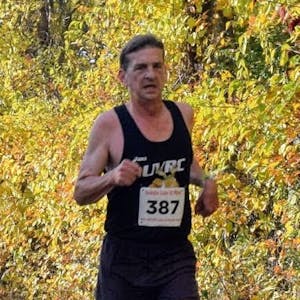
Tim Smith
Tim Smith is the former two-time president of the UVRC, and coaches winter TNT for UVRC.
